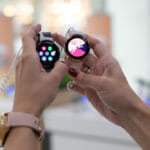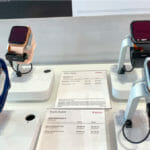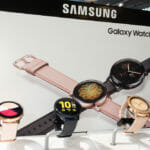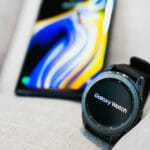When it comes to deciding on a brand new watch, things aren’t quite as straightforward as they used to be.
With watches being pretty technologically advanced these days and coming in all shapes and sizes, choosing a smartwatch can be as stressful as choosing a new phone. That’s why we are here, to make things a little simpler for you when making that choice!
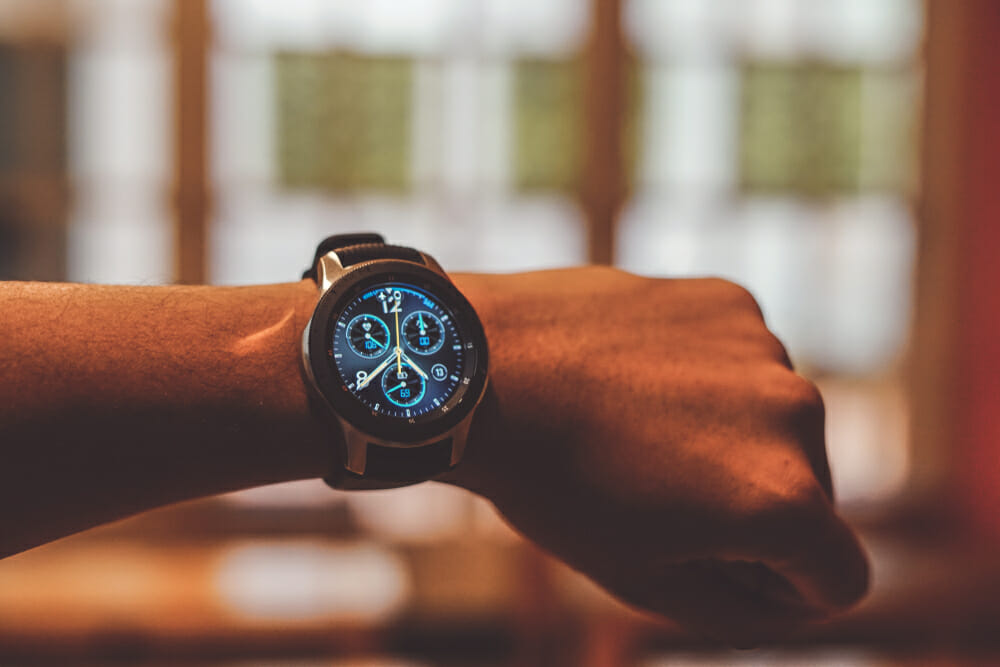
The watch that we are going to be looking at today is the Samsung Galaxy Watch 4. This smartwatch is a relatively new model, having only been released in August 2021.
It has two separate sizes- the 44mm and the 40mm- but as is to be expected with technology these days, the differences between the two are further reaching than size alone.
We’re going to be taking a look at both the 40mm and the 44mm and not only comparing them but also going through what both versions of the watch have to offer so that you can decide which size is the best fit for you personally (need to know how to measure your watch size? Read here).
With that in mind, let’s get started!
The Display
The display of a watch refers to what we see on the surface, so let’s take a look at the major display differences between the 40mm and the 44mm Samsung Galaxy Watch 4.
| Display Specifications | Samsung Galaxy Watch 4 (44mm) | Samsung Galaxy Watch 4 (40mm) |
| Size | 1.4 inches | 1.2 inches |
| Tech | Super AMOLED | Super AMOLED |
| Resolution | 450 x 450 pixels. 455 PPI. | 450 x 450 pixels. 530 PPI. |
| Features | Ambient light sensor. Scratch- resistant glass (Gorilla Glass DX+ from Corning) | Ambient light sensor. Scratch-resistant glass (Gorilla Glass DX+ from Corning) |
You’ll notice some technological jargon thrown into this section so we will go through each techie term and explain exactly what they mean to help you make your decision.
Super AMOLED: To understand what Super AMOLED stands for, we must first understand what the terms AMOLED and OLED mean. AMOLED stands for active-matrix organic light-emitting diode and this relates to a device with OLED technology.
So what is OLED? OLED refers to a light-emitting diode that contains thin, flexible sheets of organic, electroluminescent material which is used to create digital display screens.
So now we have a grasp on both OLED and AMOLED, but what is Super AMOLED? Super AMOLED is pretty much exactly what the name suggests; a super-revved-up version of AMOLED.
Super AMOLED features an integrated touch function so that rather than having a touch-sensitive layer on top of the screen, this touch-sensitive layer is integrated within the screen itself. What does this mean for your watch display screen?
Well, it adds a layer of clarity and is just generally a better viewing experience thanks to the high quality of the display. You get a greater resolution which is easier on the eyes thanks to the 100,000:1 contrast ratio.
This in turn allows for automatic adapting to all kinds of lighting environments. All of this is packed within both sizes of the Samsung Galaxy 4 Watch!
PPI (Pixels Per Inch): PPI refers to the pixels within the display screen itself, standing for pixels per inch. PPI is a method of measuring the resolution or the density of the pixels with digital displays. The larger the PPI number, the better.
A larger density of pixels within a display translates to the retention of more detail within the said display.
You will notice in the table above that the 40mm screen has a higher PPI count, meaning that the resolution and image quality is a little clearer than the larger 44mm, which has 455 PPI.
The PPI count is a noteworthy feature to consider if you find yourself straining your eyes to look at screens or – in this case- watch faces.
Although the 44mm has a larger display screen, you might want to go for the smaller 40mm Samsung Galaxy Watch 4 model if you want a clearer image to refrain from making things more difficult for your eyes.
Both watches have the same amount of pixels within their display- 450 by 450- but the smaller screen of the 40mm allows for a clearer image.
Corning Gorilla Glass DX+: Corning is a company known for making a product called Gorilla Glass- a protective layer of glass that is used for various electronic products- and one of their most modern iterations of their protective glass formula is Gorilla Glass DX+.
This improved version of the formula comes with superior resistance to scratches as well as enhanced optics to provide a clearer image.
Both the 40mm and the 44mm watches come with Corning’s Gorilla Glass DX+, so you can be certain that whichever size you choose, you are sure to be protected from knicks and scratches!
Ambient Light Sensors: These kinds of light sensors are used commonly within digital devices to maintain a level of light that is not too abrasive to the user.
Ambient light sensors will- as their name suggests- detect the level of ambient light that is present and will automatically change the lighting on the device to avoid an overly bright screen, which can be harmful to the user’s eyes.
Both versions of the Samsung Galaxy 4 utilize this technology, so you can be sure that your eyes will be protected from harsh digital lighting no matter which version you choose.
The Hardware
With that rundown of the display for both the 40mm and the 44mm Samsung Galaxy Watch, let’s now take a look at some of the external factors for this particular watch.
| Hardware Specifications | Samsung Galaxy Watch 4 (44mm) | Samsung Galaxy Watch 4 (40mm) |
| System Chip | Exynos W920 | Exynos W920 |
| Processor | 5 nm | 5 nm |
| RAM | 1.5GB | 1.5GB |
| Internal Storage | 16GB | 16GB |
| OS | Wear OS | Wear OS |
As you can see, both sizes of the watch are evenly matched when it comes to hardware! The technical jargon is back in full swing though, so to give you more of an idea about these specifications and how they work, let’s have a look at each of these terms.
System Chip: A system chip refers to the integrated circuit that controls every process of a digital device. The Exynos W920 chip is a specific chip designed for Samsung wearable devices.
Samsung is particularly proud of this specific chip, claiming an increased performance of up to 20% in comparison to the previous Exynos W9110.
With both watches using this technology, you can be sure that you will get the best possible performance with both options.
Processor: “NM” is a technical term meaning nanometer. A nanometer is a very tiny measurement- one billionth of a meter- and it relates to the process on which the chip itself is built (hence the name “processor”).
To put it simply, it’s super small and super powerful. Don’t worry, you don’t need to know much more than that!
RAM: This term stands for “Random Access Memory” and it relates to the physical hardware that is inside of the device and acts as a memory of sorts, as the name suggests! The RAM is also a method of operating various applications with a device.
The RAM will temporarily store data and is an absolute necessity in all technological devices.The RAM will always have a certain size, relating to how much space there is and how much data can be stored.
The Samsung Galaxy Watch 4 has a RAM size of 1.5GB, which is pretty spacious for a watch. Despite the size difference, the 40mm and the 44mm both have the same amount of RAM.
Internal Storage: Internal storage is often overlooked when it comes to smartwatches and the Samsung Galaxy Watch 4 is no exception!
Both size variations offer 16GB of internal storage, which is almost double the storage that was offered with the previous model. This allows for plenty of room for a wide range of apps if you so choose.
OS: You’ve likely seen this term thrown around a lot when it comes to digital and technological products, particularly when it comes to updating the system software on your phone.
OS stands for “operating system” and relates to the software downloaded onto a digital product to manage the corresponding hardware and software resources, as well as managing the common services within a device as well.
The Samsung Galaxy Watch 4 utilizes a new operating system called “Wear OS” that is used for both versions of the watch and is an OS designed just for Samsung products.
Samsung partnered with Google on this particular operating system, designed specifically for watches.
Again, this is an element that is used on both the 40mm and the 44mm, so the user experience in terms of the operating system will be the same no matter which size watch you decide on.
The Battery
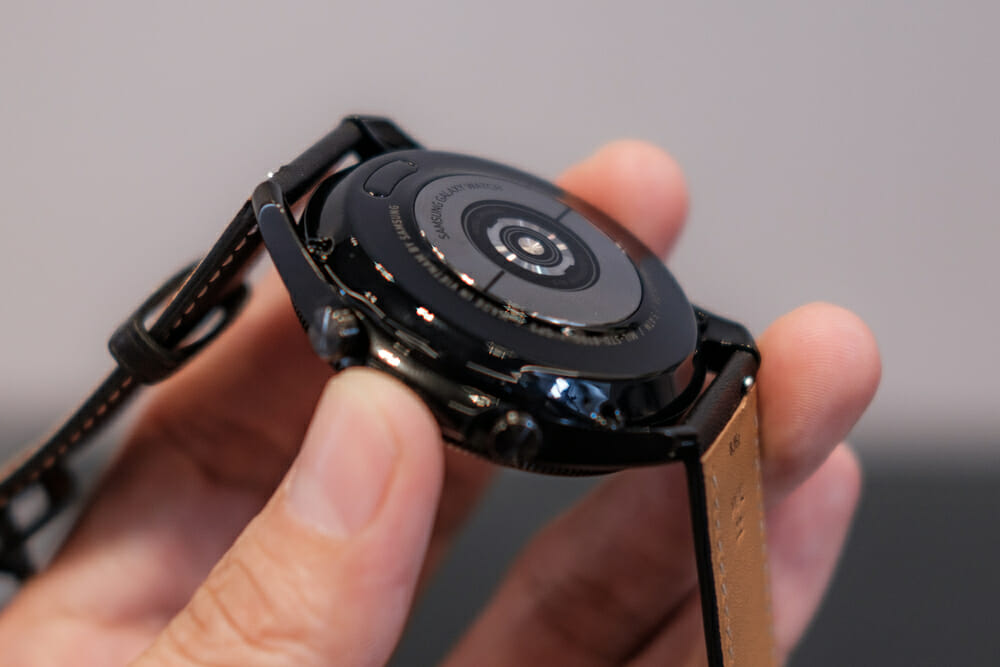
Now that we are up to date on several of the external and internal elements for both the 40mm and the 4mm, let’s take a look at the battery information.
This is always a handy element to keep in mind when deciding, especially if you know that you need a watch with significant battery life.
| Battery Information | Samsung Galaxy Watch 4 (44mm) | Samsung Galaxy Watch 4 (40mm) |
| Capacity | 361 mAh | 247 mAh |
| Type | Li-Ion. Not replaceable by the user. | Li-Ion. Not replaceable by the user. |
| Charging | Qi Wireless charging/ | Qi Wireless charging. |
There are not too many glaring differences on the battery front for both sizes, but there is a difference in the mAh. We are at it again with that technological jargon, so let’s break it down to make it easier to get a grasp of the information.
Battery mAh: mAh is a term that stands for “milliampere-hour” when discussing the battery capacity for smaller electrical products. It relates to the amount of energy that is stored within a battery.
Milliampere is a unit of measurement referring to the current within a small battery and so “milliampere-hour” tells us how much current a battery uses within an hour. The 44mm uses 361 mAh whilst the 40mm uses 247 mAh.
This is not too much of a surprise, seeing as the 44mm is a little bit larger. With that in mind, it makes sense that it would use a little bit more power than the smaller model.
The 361 mAh of the 44mm will give you about two day’s worth of battery power before a recharge is needed. The 247 mAh can charge anywhere from 24 hours plus.
It might not seem like a big difference, but if battery life is an important factor to you personally then this is something to consider. If you need a watch that can last even a little longer in terms of battery life, the smaller 40mm might be better for you.
The batteries used (lithium-ion batteries) and the charging methods (WPC-based wireless charging, which stands for Wireless Power Consortium) are the same for both models though, which is useful as it keeps the charging nice and simple no matter which model you opt for.
Keep in mind that the batteries for both the 40mm and the 44mm are non-removable.
The Design
We’ve covered the internal workings of the Samsung Galaxy Watch 4 as well as the external elements. We’ve also had a look at the battery for both the 40mm and the 44mm.
Next up, it is time to take a look at the design for both watches- including the measurements- to see if there are any major differences between the smaller and larger sizes.
| Design | Samsung Galaxy Watch 4 (44mm) | Samsung Galaxy Watch 4 (40mm) |
| Colors | Black, Green and Silver | Black, Silver and Pink Gold |
| Measurements | Dimensions: 44 x 43.3 x 9.8mm. Weight (Excluding Straps): 30g.Strap Size: compatible with 22mm wide straps (standard). | Dimensions: 40.4 x 39.3 x 9.8mm.Weight (Excluding Straps): 26g.Strap Size: compatible with 20mm wide straps (standard). |
| Resistance | Certified MIL-STD-810 and IP68. Dust resistance. Water-resistance (up to 50 meters) | Certified MIL-STD-810 and IP68. Dust resistance. Water-resistance (up to 50 meters) |
Dimensions: It might be handy to take note of the dimensions of both watches when it comes to choosing between the 40mm and the 44mm.
You might find that one is a better fit for you personally than the other. If you are more petite and have smaller wrists, the 40mm might be better for you whereas larger wrists can be accommodated more easily by the bigger 44mm option.
Weight: Although the 44mm is a tiny bit heavier, both of these watches are incredibly lightweight, which is always a bonus.
Big, bulky watches can be more of a hindrance than a help at times and so the lightweight nature of both sizes of the Samsung Galaxy 4 is sure to be a definite plus point.
Colors: What we can also ascertain from this information is that there are different color schemes available for both models. This might not make a difference in terms of performance but we all have our preferences when it comes to color.
The different color options might be enough to change your mind when considering which of the two sizes to invest in! The 40mm has a pink gold option whilst the 44mm has a green option.
Both sizes are available in black or silver, both of which are popular and modern color options.
There’s a little bit of jargon at the end there under the resistance category, so let’s take a quick look to decipher what exactly it means.
IP68 and MIL-STD 810: These certifications relate to tests that have been undertaken on the device to prove their resistance to various hazards such as water and dust.
These certifications mean that the Samsung Galaxy Watch 4 has been tried and tested and is well protected against various environmental factors. Well protected doesn’t mean impervious though!
Make sure to keep the watch in a safe place to avoid any unwanted damage.
Fitness
The Samsung Galaxy Watch 4 is significantly well versed in fitness, with various features that allow you to keep track of your health and your body.
These are included in both the 40mm and the 44mm, so you don’t have to worry about having to choose certain features over others. Some of the features utilized include:
Tracking For The Following
- Blood Oxygen
- Blood pressure
- Calories
- Distance
- ECG
- Heart Rate
- Sleep
- Steps
- Stress Level
- Incidental Falls
- V02 Max
- Swimming
- On-Screen Workout
Sensors Related To The Following
- Accelerometer
- Altimeter
- Ambient Light
- Barometer
- Compass
- Gyroscope
- HRM
- Pulse Oximeter (SP02)
- BIA Sensor
The Verdict
Hopefully, this guide has given you a bit of insight into both the 40mm and the 44mm versions of the Samsung Galaxy Watch 4 as well as an idea as to which version could be the best suited for your personal needs.
There isn’t a massive difference between the two and the differences that do arise are those that are to be expected with a larger and smaller size of the same product.
For instance, the longer battery life and the larger display size of the 44mm aren’t particularly surprising seeing as it is a bigger option in general.
It might be that you need a watch that has a slightly longer battery life or has a display screen that is a little bit less pixelated.
It all comes down to your personal preferences at the end of the day, so have a proper read of this guide and make the choice that suits you best!
It could also be useful to measure your wrist before you decide on the 40mm or the 44mm due to the slight differences in the strap and watch sizes. The last thing you want is to invest in a watch only for it to be too big or too small for your wrist!
Take your measurements and then make your choice!
- Can You Use Bluetooth Headphones on Xbox? A Quick Guide for Gamers - July 16, 2025
- Can You Use Bluetooth Headphones on Switch? A Quick Guide for Gamers - July 15, 2025
- How Connect Bluetooth Headphones to TV: Simple Guide - July 15, 2025

